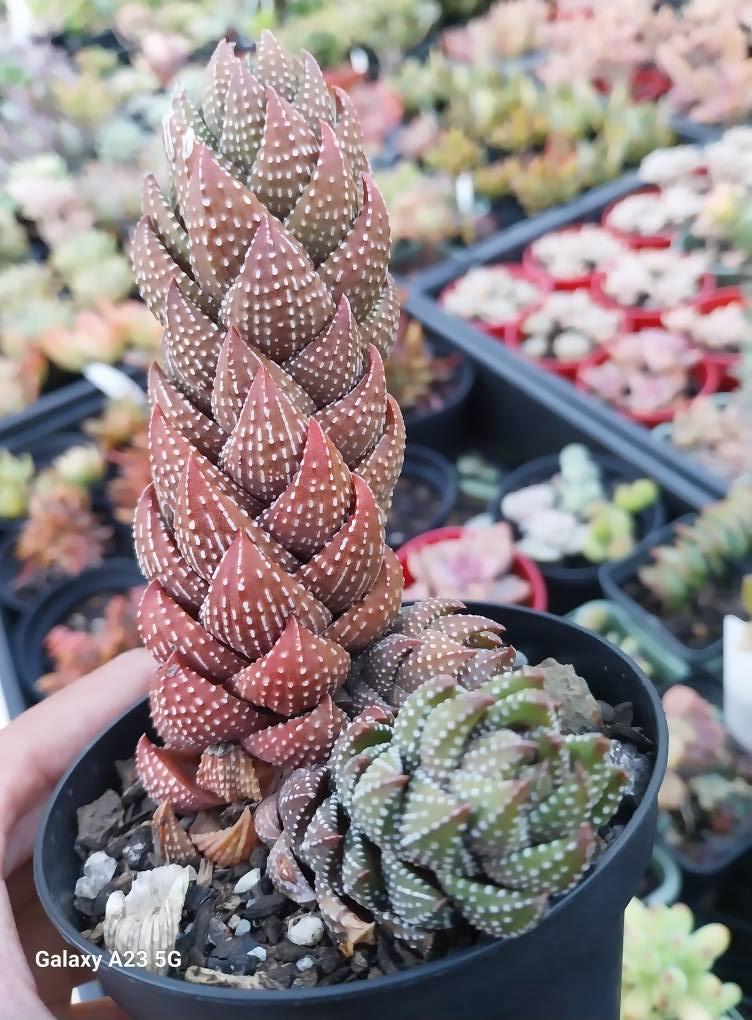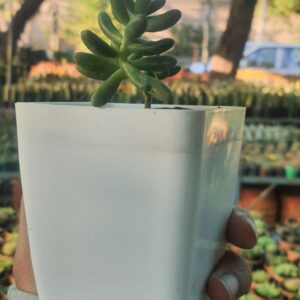🌿✨ The Stacked Rosette Succulent is known as Haworthia coarctata.
A notable, columnar succulent distinguished by its thick, spiraling rosettes of pointed, dark green leaves dotted with white tubercles is Haworthia coarctata. Because of its architectural shape, simplicity of maintenance, and capacity to thrive in indoor conditions, this species—which is indigenous to the Eastern Cape of South Africa—is popular among succulent aficionados.
Although frequently mistaken for Haworthia reinwardtii, coarctata typically features a more compact growth habit and smoother, rounder tubercles. This plant, which grows slowly, is ideal for terrariums, windowsills, succulent arrangements, and tiny pots.
🌿 Botanical Synopsis
Scientific Name: Haworthia coarctata
Family: Asphodelaceae
Common Name: Haworthia coarctata
South Africa, Eastern Cape is where it came from.
Upright, cluster rosettes are a characteristic of its growth habit.
Size:
Height: 4-8 inches (10-20 cm)
Clumps may reach a width of 10 inches (25 cm) or more, with offsets.
Appearance
Foliage:
Dark green leaves that are thick and pointed
Organized in a small, upright spiral
The white, elevated tubercles that dot the leaves give them a textured and attractive look.
Under sun stress, the tips of the leaves may turn reddish.
Flowers:
Creates tall, slender flower spikes with tiny, tubular blooms that are white or light pink in color.
The majority of the time, blooms occur between late spring and early summer, but flowering is less frequent indoors.
☀️ Requirements for Light
Inside:
Likes indirect, bright light
Does well close to windows facing east or south
Although it can withstand low to moderate light better than many succulents, its growth rate decreases and its color may fade.
Outside:
Thrives in partial shade
To avoid scorching, shield against the intense afternoon sun.
Hint: Bright light exposure can induce a natural protective reaction in the leaves, causing them to turn reddish or purple.
🌡️ Humidity and Temperature
Temperature:
Best range: 18–26°C (65–79°F)
Although it can withstand short periods of 5°C (41°F) exposure, it is not frost-hardy.
Optimal growth occurs inside or in USDA hardiness zones 9–11.
Humidity:
Likes moderate to low humidity levels.
Maintain adequate airflow to prevent fungal problems.
💧 Watering Schedule
From Spring to Autumn (Growing Season):
Water when the top 1–2 inches of soil are dry
Typically, every 10 to 14 days, taking into account the surrounding environment
Use the soak and dry method: thoroughly water the soil, then allow it to dry completely.
Winter (Dormancy):
Water sparingly—approximately once every three to four weeks
Root rot is frequently caused by overwatering during the winter.
Demands for Soil
Kind:
demands gritty soil that drains well
Suggested combination:
half cactus and half succulent mix
25% pumice or perlite
25% fine gravel or coarse sand
pH range: mild acidity to neutrality (6.0 to 7.0)
To avoid water retention, always use pots with drainage holes.
Adding fertilizer
Summer and spring feeding:
For succulents, use a diluted balanced liquid fertilizer (half strength).
Use once a month
Stay away from using fertilizer during the fall and winter.
✂️ Upkeep & Pruning
Little maintenance:
Take out any dead or dried leaves from the base.
When the flowers are done blooming, cut the stalks.
To enhance photosynthesis and eliminate dust, gently clean the leaves.
🌿 Propagation
Pups: Offsets
produces offsets (baby plants) around the base
When pups are big enough, use clean, sharp tools to separate them.
Before planting in dry soil, let the cut areas callus for one to two days.
Leaf Cutting:
Although feasible, offsets are less trustworthy and slower.
Seeds: Infrequently multiplied by seed because of the sluggish growth rate.
The best way to propagate is through offsets.
🛡️ Typical Issues
Overwatering: Causes mushy leaves and root rot
Underwatering: Can result in wrinkling or shriveling.
Pests:
Mealybugs
Spider mites
Insects of the scale family
For pest management, use neem oil, insecticidal soap, or manual removal.
Toxic: ⚠
Not harmful to people or animals
Suitable for families with pets and children
Use as a decoration
Perfect for:
Indoor succulent presentations
open terrariums
desks in the office
window sills
Mild-weather rock gardens
It’s a wonderful addition to any plant collection because of its simple maintenance and architectural, upright shape.
✅ Conclusion
Haworthia coarctata is an eye-catching, hardy succulent that is ideal for hobbyists and newcomers alike. It’s a simple and enjoyable plant for indoor or patio gardening because of its distinctive shape, ability to withstand low light levels, and minimal upkeep requirements.
Office Plants, Succulents
Haworthia Coarctata
₨799.00
Haworthia Coarctata
Stacked leaf succulent with upright growth and rich green texture—perfect for shelves, terrariums, and sculptural plant design.





Reviews
There are no reviews yet.